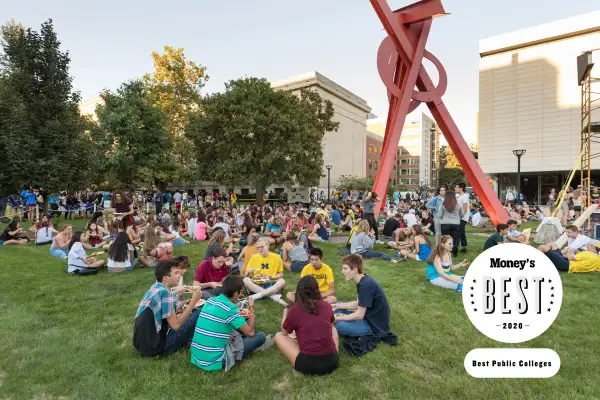The 10 Best Public Colleges in the U.S.

More than 14 million Americans are currently enrolled in public colleges — almost triple the amount of those attending private schools.
In most cases, public institutions are more affordable than their private counterparts, with the average published tuition for in-state students totaling $10,440, compared to $36,880 at private schools. But for many students, the appeal goes beyond their price tag.
Public colleges tend to be larger, and as a result, they have a broad academic offering, boasting hundreds of academic programs and plenty of research opportunities. Public institutions are also big on extracurricular activities, offering a long list of premiere athletic programs, clubs and student organizations for a well-rounded college experience.
To come up with our top picks, we started by looking into our Best Colleges rankings database, consisting of over 730 four-year schools that represent the best in their class in three main categories: affordability, quality of education, and student outcomes.
With families’ budgets limited by the coronavirus pandemic, we know now more than ever that cost and access to financial aid play an important role in choosing a college. That's why we placed special emphasis this year on our affordability measures, highlighting metrics like the average price of a degree, typical costs for students in different income groups, and average student debt. We also examined other factors to help us determine student success, including average graduation rates and early career earnings, as reported by alumni to PayScale.
The list below features public colleges with graduation rates that are well above the national average, and whose alumni earn upwards of $54,100 within the first five years of graduating. You can see the full list of public colleges here, and check out other popular rankings here.
1. University of Michigan-Ann Arbor
- Est. price with average grant: $17,600
- % of students with need who get grants: 81%
- Graduation rate: 92%
- Average salary within 5 years of graduation: $63,700
The University of Michigan is currently ranked as the #1 public research university by the National Science Foundation, based on the money spent on research. More than 1,500 undergraduate students participate in its Undergraduate Research Opportunity program each year. But just because it offers top-notch education that doesn’t mean it’s crazy expensive: more than half of undergraduate students receive grants, according to data from Peterson's Guide. The Wolverines are also big on sports, competing in 29 NCAA Division I teams, the most popular being football, basketball and ice hockey. The university has made it to the top 10 standings of the Learfield IMG College Directors’ Cup — an award that’s given to institutions with broad, successful sports programs — in 20 out of the 26 seasons it has been running. U-M also has the largest collegiate stadium in the country. Nicknamed “The Big House,” it can fit over 100,000 spectators.
2. University of Virginia
- Est. price with average grant: $18,600
- % of students with need who get grants: 87%
- Graduation rate: 94%
- Average salary within 5 years of graduation: $61,400
Known as a “public Ivy,” the University of Virginia offers an outstanding education at a reasonable price. Its campus is in Charlottesville, in a beautiful natural setting just east of the Blue Ridge Mountains. Students get to experience college life inside a UNESCO World Heritage Site designed by its founder, Thomas Jefferson. The university is known for its medicine and health programs, having one of the country’s most renowned academic medical centers. UVA’s 12 schools offer a variety of programs, such as neuroscience, linguistics, Latin American studies, archaeology, and urban and environmental planning.
3. University of California-San Diego
- Est. price with average grant: $14,100
- % of students with need who get grants: 95%
- Graduation rate: 86%
- Average salary within 5 years of graduation: $59,300
Technically located in La Jolla, the University of California, San Diego is big on science programs. Its Scripps Institution of Oceanography, for example, owns a small fleet of mobile research labs, so students have the opportunity to study the ocean at innovative, state-of-the-art facilities. The school is also ethnically diverse, with about 34% of its student population identifying as Asian and 20% as Hispanic/Latino. UC San Diego’s six undergraduate colleges offer more than 130 programs; the most popular being biology, mathematics, economics, computer science and computer engineering, and chemistry.
4. University of California-Davis
- Est. price with average grant: $16,400
- % of students with need who get grants: 97%
- Graduation rate: 86%
- Average salary within 5 years of graduation: $57,100
UC Davis is best known for its studies in agriculture and animal science, offering programs such as environmental toxicology, sustainable environmental design, viticulture, and animal biology. Close to 60% of the school’s undergraduate Californian students have their tuition and fees covered by grant aid. Besides its outstanding academics, UC Davis also offers a fun and vibrant campus life. The school borders the city of Davis (one of the safest college towns in the country), which is rich in entertainment, with plenty of cafés, thrift stores, bars, a farmers market, and three movie complexes.
5. Texas A & M University-College Station
- Est. price with average grant: $20,000
- % of students with need who get grants: 82%
- Graduation rate: 82%
- Average salary within 5 years of graduation: $59,200
Texas A&M has the largest student body in the nation, with over 54,000 undergraduates. The school has over 130 undergraduate degrees. Some of the university’s most popular programs are business, agriculture and engineering. The university is also home to one of the nation’s largest intramural sports programs, with 12,000 students participating each year. Extracurricular activities are also a huge part of campus life, with more than 1,100 clubs and organizations, including 58 fraternities and sororities, and the school’s Corps of Cadets.
6. University of California-Irvine
- Est. price with average grant: $15,700
- % of students with need who get grants: 96%
- Graduation rate: 83%
- Average salary within 5 years of graduation: $55,900
The University of California, Irvine was founded in 1965 and is the youngest member of the Association of American Universities, a group of 65 leading research institutions. It has over 30,000 undergraduate students: over one-third of them identify as Asian and more than 20% as Hispanic or Latino. Some of the most popular majors at UCI include computer science, biology, business, mechanical engineering, social psychology and public health. UCI may not be known as a sports powerhouse, but its teams have won 28 national titles across nine sports, and it was the first public university to incorporate an e-sports division. UCI’s faculty is top-notch, too, with professors who’ve won the Nobel Prize, the Pulitzer Prize, the National Medal of Science and the National Humanities Medal.
7. California State Polytechnic University-Pomona
- Est. price with average grant: $13,300
- % of students with need who get grants: 80%
- Graduation rate: 71%
- Average salary within 5 years of graduation: $55,500
Cal Poly Pomona offers students the opportunity to not only learn in theory but also in practice, with a “learn-by-doing” educational approach. The university has over 26,000 undergraduate students and its most popular programs are engineering, business, hospitality management, agriculture, and apparel merchandising and management. The school’s main mission is to provide quality education at an affordable price. In-state students only pay a little over $7,000 for tuition and fees per academic year. Cal Poly has over 600 student clubs and organizations, including an agricultural biology club, an artificial intelligence club, a scuba diving club and a computer gaming club.
8. University of Florida
- Est. price with average grant: $11,800
- % of students with need who get grants: 62%
- Graduation rate: 90%
- Average salary within 5 years of graduation: $54,100
The University of Florida is one of the most affordable colleges on our list. Floridians only pay about $6,400 a year for tuition and fees. Students can choose from 100 undergraduate programs, including biology, interior design, education, botany, geology, business, and economics. UF has over 200 research centers and institutes, and students don’t have to wait until they’re upperclassmen to get in on the action — freshmen and sophomores can also conduct research. One of the university’s strong suits is its athletic programs. The university claims 36 national championships spread among 14 different sports, including most recently track and field in 2019. UF’s fan section at basketball games, the Rowdy Reptiles, was even voted as one of the best student fan sections in the NCAA.
9. University of California-Berkeley
- Est. price with average grant: $18,700
- % of students with need who get grants: 94%
- Graduation rate: 91%
- Average salary within 5 years of graduation: $65,800
UC-Berkeley, commonly known as Cal, is one of the country’s most respected research institutions. Undergraduate students can participate in one of the school’s 80 research projects in a variety of disciplines, ranging from linguistics to molecular biology. One of the university’s most recent ventures is the study of neutron stars. The National Science Foundation recently awarded Cal more than $10 million to build a center dedicated to the study of the celestial bodies. But getting in can be tough: Cal is one of the most selective public universities in the country, with an acceptance rate of roughly 17%. Its faculty includes MacArthur fellows, Pulitzer Prize winners and Nobel Prize recipients.
10. University of California-Los Angeles
- Est. price with average grant: $15,700
- % of students with need who get grants: 96%
- Graduation rate: 91%
- Average salary within 5 years of graduation: $57,600
UCLA is the most applied-to university in the United States. In fact, this fall the college received over 100,000 freshman applicants. Located in the City of Angels, it should be no surprise that the university’s school of Theater, Film, and Television is among the best in the nation. Some of the university’s most notable Hollywood alumni include Mariska Hargitay, Jack Black, and James Franco. More than half of the school’s undergraduates receive some form of financial aid, with the average grant award being about $18,800. UCLA offers over 125 majors, and most undergraduate classes have 30 students or less. The university has more than 1,000 student clubs and organizations, including a Campus Events Commission, which hosts free sneak previews of films on campus.
More from Money:
How Applying to College Will Be Different This Year, Thanks to the Coronavirus Pandemic
